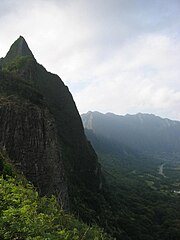Forest consecration
| Forest consecration | ||||||||||||
|---|---|---|---|---|---|---|---|---|---|---|---|---|
| Systematics | ||||||||||||
|
||||||||||||
| Scientific name | ||||||||||||
| Circus dossenus | ||||||||||||
| Olson & James , 1991 |
The forest harrier ( Circus dossenus ) is an extinct bird of prey from the genus of the harrier ( Circus ), which was native to the Hawaiian islands of Oahu and Molokaʻi . She lived in the Holocene and was smaller and lighter than all orders alive today. The forest harrier inhabited dense forests and presumably ate birds and insects. In all probability it died out as a result of the colonization of Hawaii by the Polynesians and the neozoa that were introduced with them .
features
The forest consecration was the smallest known type of consecration. The skeletal parts found do not reach the size of those from recent consecrations. Only in terms of the length of the thigh bones is the wood harrier approximately the same as the meadow harrier ( C. pygargus ) and the magpie harrier ( C. melanoleucus ). Striking are the proportionally short wings and breast bones, which are more reminiscent of representatives of the hawks ( Accipiter ) and probably represent an adaptation to the insular, wooded environment.
habitat
The forest harrier inhabited dense, subtropical forests, as they prevailed in Hawaii before the arrival of humans and in parts still exist today. There it was likely to feed on insects and small birds such as honeysuckle , as all of today's Hawaiian land mammals first arrived on the islands with the Polynesians . Above all, the Polynesian rat ( Rattus exulans ) and bird malaria contributed to the extinction of many endemic species, which is likely to have doubly affected the forest harrier as a ground-breeder and carnivore . The same fate befell other birds, such as the owls of the genus Grallistrix .
distribution
As things stand today, it can be assumed that the forest harrier was endemic to Hawaii. The subfossil finds are currently limited to Molokaʻi and Oʻahu , where only very rudimentary remains have been found. The distribution probably also included other islands that were connected with Molokaʻi to Maui Nui before the last Ice Age .
Discovery and systematics
Remains of the forest harrier were first discovered in the 1980s by Storrs Olson and Helen James on Oahu. The proportions of the sparsely preserved bones, which are unusual for consecrations, led - similar to the New Zealand Eyles consecration ( C. teauteensis ) - to the fact that the species was mistaken for a hawk and also described as such. It was not until 1991 that Olson and James were able to correct this assumption on the basis of new material from Moloka'i and describe the species as belonging to the consecration. They chose dossenus as the specific epithet , which they explained as follows:
“Dossenus, Latin for a clown or fool, without whom no circus can do; particularly suitable here, as the species initially made a fool of us with regard to its genus. "
They noted that harriers have penetrated further into the Pacific island world than hawks: the former had only reached Fiji in the course of their development history , while the marsh harrier ( C. approximans ) had reached Tonga . The hen harrier ( C. cyaneus ) or Hudson harrier ( C. hudsonius ) have already been sighted in Hawaii , which makes the development of a Hawaiian species of harrier seem plausible.
die out
The forest harrier is known only from subfossil bones and likely died out before Europeans reached Hawaii. Since most are ground breeders, the species as such would have been susceptible to the Pacific rats and domestic pigs introduced by the Polynesians from the 13th century ; on top of that, the forest consecration was also dependent on intact, dense forests. The clearing of these forests may have been the main cause of their disappearance.
References
literature
- Julian Pender Hume, Michael Walters: Extinct Birds. A&C Black, London 2012. ISBN 140815725X .
- Storrs L. Olson , Helen F. James : Descriptions of thirty-two new Species of Birds from the Hawaiian Islands. In: Ornithological Monographs 45, June 1991. ISBN 0-935868-54-2 . (Available online as PDF )
- Harold Douglas Pratt: The Hawaiian honeycreepers: Drepanidinae. Oxford University Press, 2005. ISBN 019854653X
- Alan C. Ziegler: Hawaiian natural history, ecology, and evolution. University of Hawaii Press, 2002. ISBN 0824821904
Individual evidence
- ^ A b c Storrs L. Olson, Helen F. James: Descriptions of thirty-two new Species of Birds from the Hawaiian Islands. In: Ornithological Monographs 45, June 1991. ISBN 0-935868-54-2 , p. 67.
- ↑ Olson & James 1991, p. 65.
- ↑ Olson & James 1991
- ↑ Hume & Walters 2012 , p. 79.
